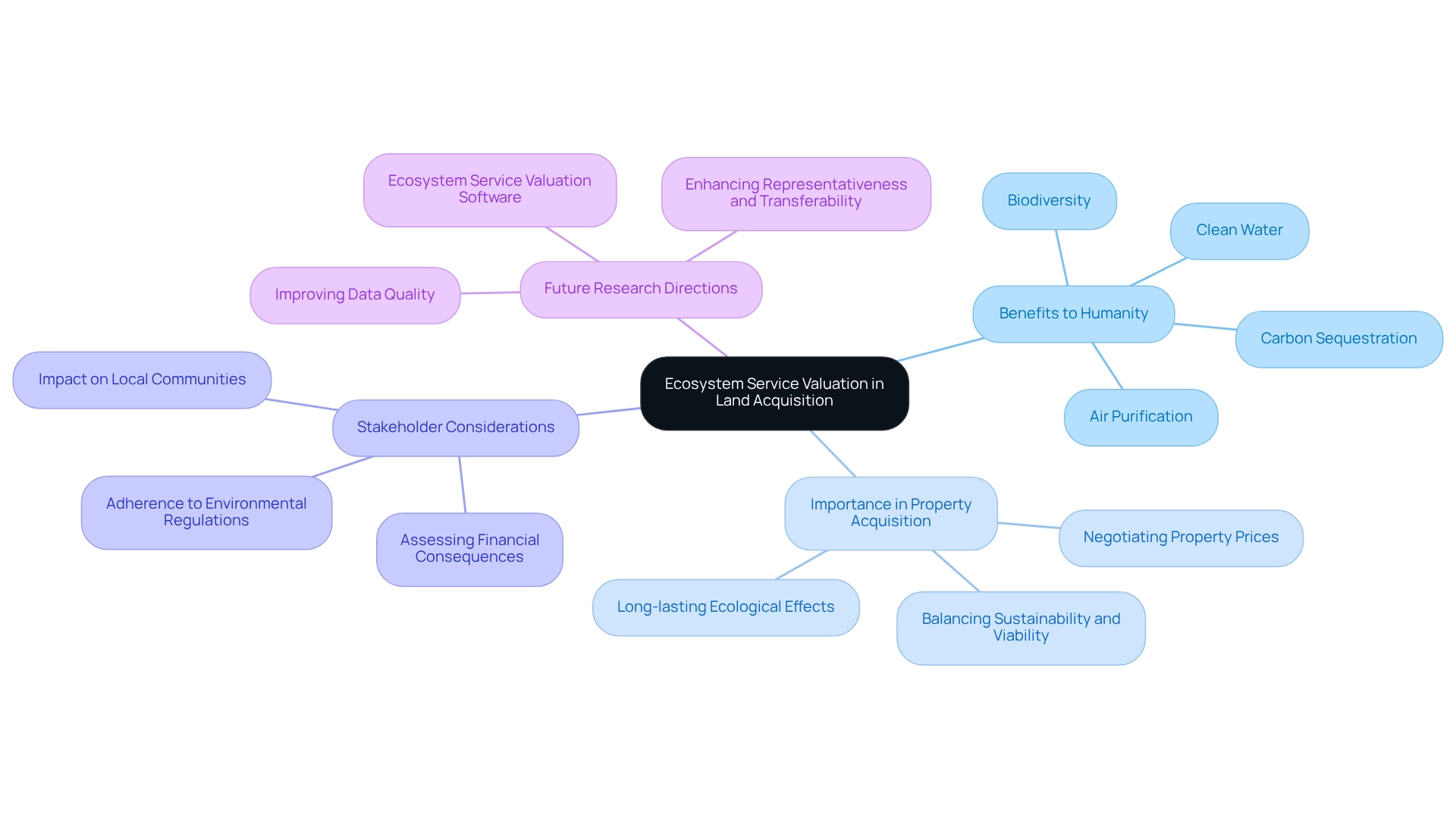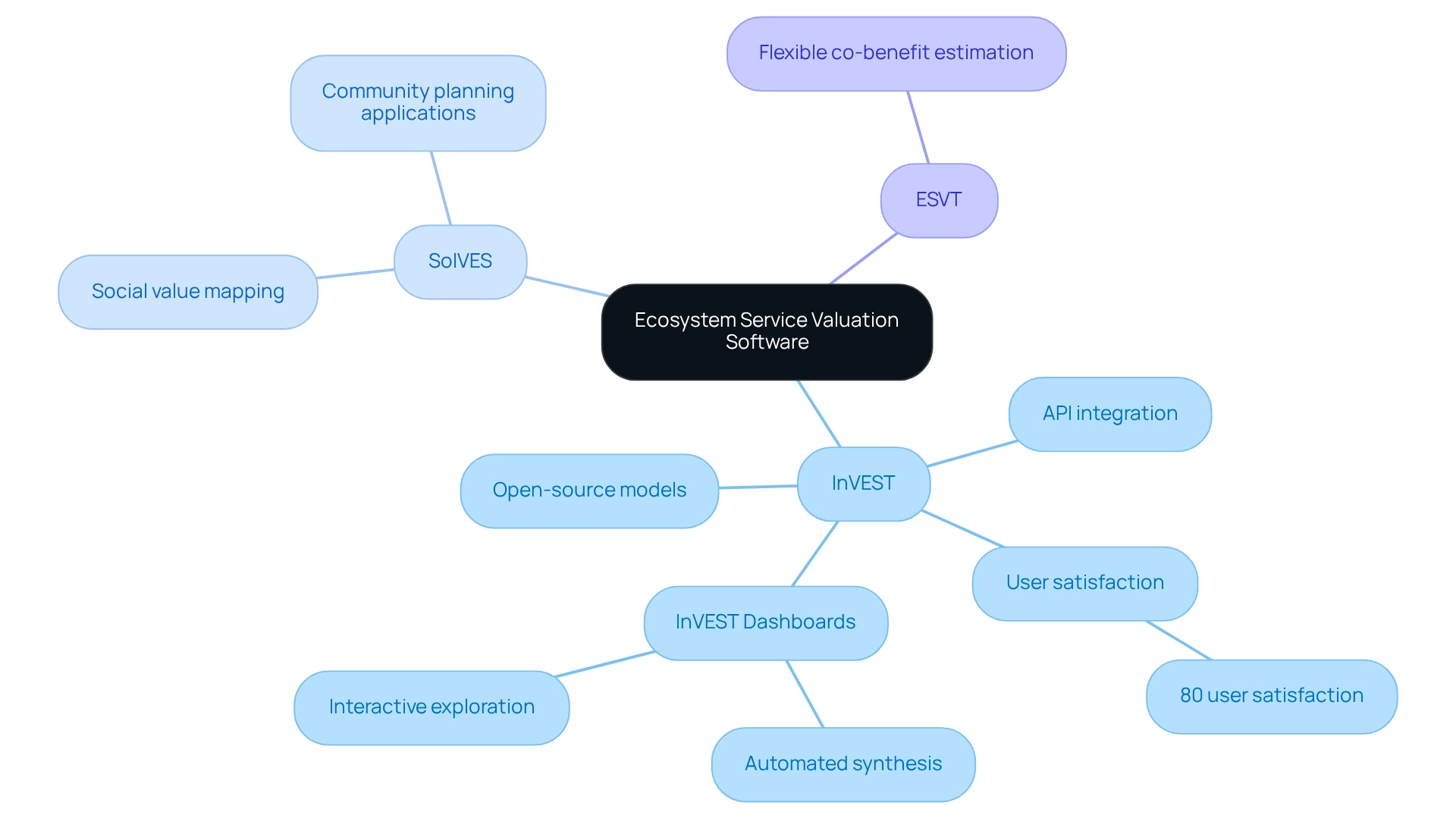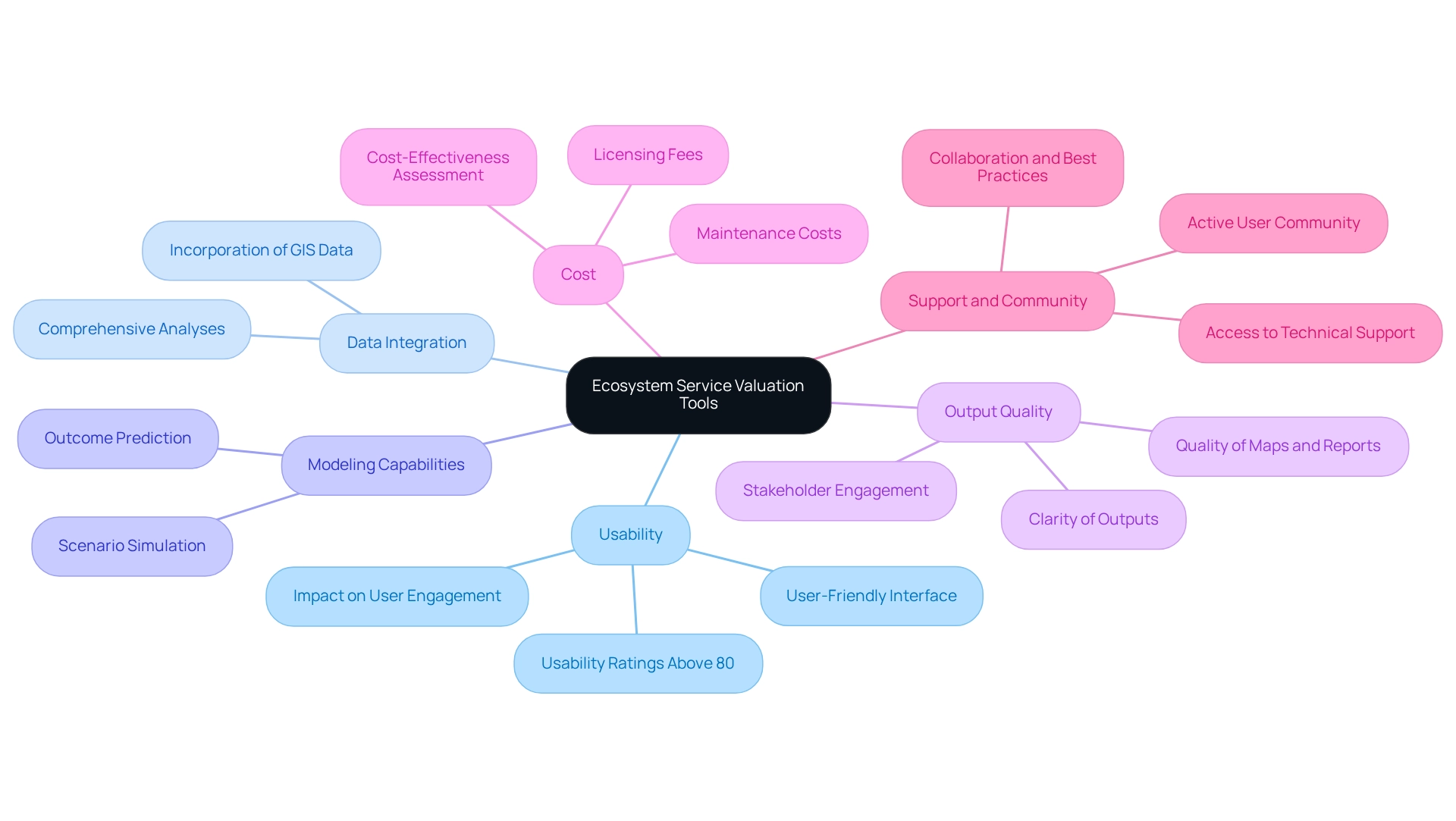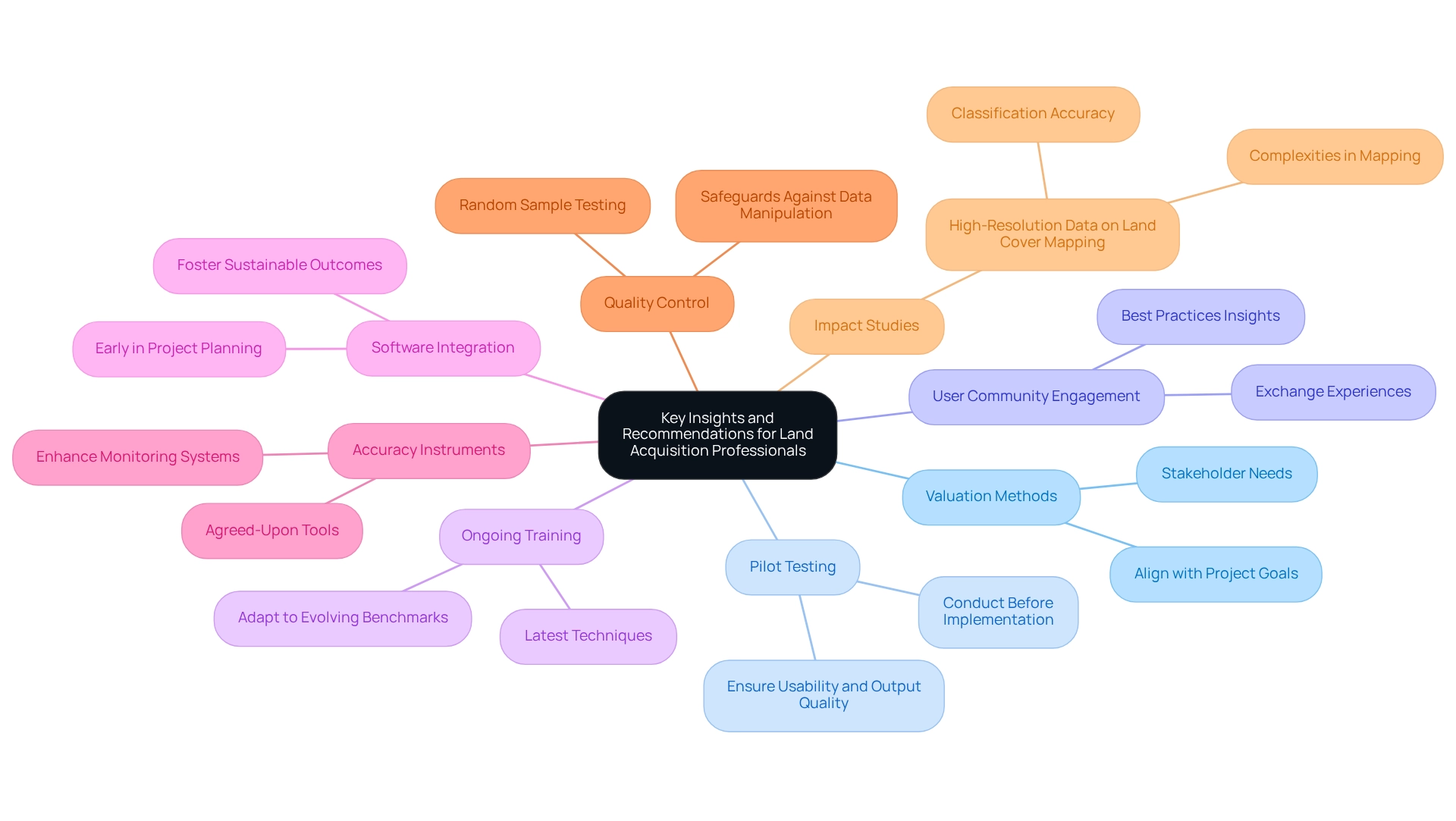Overview
This article provides a compelling examination of various ecosystem service valuation software tools designed to facilitate informed land acquisition decisions by quantifying the benefits offered by natural systems. It underscores the critical role of tools such as InVEST and SolVES in refining decision-making processes and enhancing stakeholder engagement. Furthermore, it delineates essential criteria for evaluating these tools—usability, data integration, and output quality—each vital for developing effective property management strategies.
The complexities of land acquisition present significant challenges, including intricate legal and regulatory frameworks. By leveraging advanced valuation tools, organizations can navigate these challenges more effectively, ensuring that decisions are grounded in comprehensive data and analysis. The benefits of utilizing these tools not only streamline the acquisition process but also foster greater stakeholder collaboration and understanding.
In conclusion, the article advocates for a thorough evaluation of ecosystem service valuation tools, highlighting their potential to transform land acquisition strategies. It invites stakeholders to consider these innovative resources as integral to their decision-making arsenal, ultimately enhancing the management of natural resources.
Introduction
In the realm of land acquisition, the critical importance of understanding the value of ecosystem services cannot be overstated. Stakeholders are increasingly faced with the challenge of balancing environmental stewardship with economic demands. Ecosystems deliver invaluable benefits—ranging from clean water and air purification to biodiversity and carbon sequestration—that significantly influence decision-making processes. As urban populations surge and the pressure on land resources intensifies, integrating ecosystem service valuation into acquisition strategies is essential.
This article delves into the complexities of land acquisition, including the legal and regulatory challenges that professionals encounter. By showcasing leading software tools designed to facilitate ecosystem service valuation, we aim to provide key insights for land acquisition professionals. These insights are vital for enhancing strategies while ensuring compliance with environmental standards.
Understanding these services not only addresses immediate economic needs but also fosters long-term sustainability. As we explore this topic, consider how these insights can transform your approach to land acquisition, ultimately leading to more informed and responsible decision-making.
Understanding Ecosystem Service Valuation in Land Acquisition
Valuation of natural systems quantifies the numerous advantages these environments offer to humanity, such as clean water, air purification, carbon sequestration, and biodiversity. In property acquisition—particularly for energy projects—understanding these values is crucial for making informed choices that balance environmental sustainability with economic viability. Stakeholders must assess not only the short-term financial consequences of property acquisitions but also the long-lasting ecological effects and advantages gained from the natural systems inherent to that area. This valuation process is essential in negotiating property prices, assessing potential impacts on local communities, and ensuring adherence to environmental regulations.
Recent research indicates that the financial worth of environmental benefits significantly impacts acquisition returns, often more than anticipated development risks. As city populations continue to grow—projected to reach 60% worldwide in the next ten years—integrating natural resource valuation into property acquisition strategies becomes increasingly vital. The case study titled 'Future Development of Ecosystem Service Valuation Software' underscores the need for enhanced data quality and application, which is critical for guiding better policy and management choices in property acquisition. Future studies aim to improve the representativeness and transferability of resource valuations through ecosystem service valuation software, ultimately providing practical applications that can inform property acquisition strategies.
How will your organization adapt to these evolving challenges? By recognizing the importance of natural systems in your decision-making process, you can position yourself for success in an increasingly complex landscape.

Overview of Leading Ecosystem Service Valuation Software
In the realm of land acquisition, the efficiency of ecosystem service valuation software among multiple applications in resource valuation cannot be overstated. Each ecosystem service valuation software offers unique characteristics tailored to different needs. InVEST (Integrated Valuation of Services and Trade-offs) emerges as a leading choice, featuring a suite of open-source models specifically designed for mapping and valuing natural services. This software not only computes potential human advantages derived from natural systems—such as carbon sequestration and crop pollination—but also integrates seamlessly into more complex workflows via its Application Programming Interface (API) within the Python programming language. The API documentation for InVEST is readily available online, serving as a valuable resource for users aiming to implement the software effectively. Recent updates have further enhanced its functionality, solidifying its position as a strong option for property acquisition professionals.
Another significant tool is SolVES (Social Values for Ecosystem Services), which quantifies and maps the perceived social values associated with natural systems. The practical applications of SolVES underscore its effectiveness in engaging stakeholders and guiding resource management decisions by visualizing the social values linked to environmental benefits. For instance, case studies have illustrated how SolVES has been employed in community planning to assess the social impacts of usage changes. Additionally, the Services Valuation Tool (ESVT), developed by the Trust Alliance, offers a flexible approach for trusts to estimate the worth of co-benefits generated by natural systems.
Each of these tools, particularly the ecosystem service valuation software, plays a crucial role in resource value assessment, providing insights that facilitate informed decision-making in property acquisition processes. User satisfaction statistics reflect a strong preference for ecosystem service valuation software like InVEST and SolVES among practitioners, with recent surveys indicating that over 80% of users report high satisfaction levels regarding the features and usability of these solutions. Moreover, InVEST Dashboards automate the synthesis and visualization of model outputs, enabling easier sharing and comprehension of results—an essential aspect for effective communication among stakeholders. These dashboards allow users to explore results interactively, enhancing the overall user experience and fostering stakeholder engagement.

Comparative Criteria for Evaluating Ecosystem Service Valuation Tools
When assessing ecosystem service valuation software, several key criteria emerge as essential for effective land acquisition.
- Usability: A user-friendly interface is paramount, enabling individuals with varying expertise to navigate the software seamlessly. High usability ratings are crucial, as they directly impact user satisfaction and efficiency. According to recent studies, resources with usability ratings above 80% significantly enhance user engagement and productivity.
- Data Integration: The capability to incorporate diverse data sources, particularly GIS data, is vital for producing accurate assessments. Leading software solutions excel in this area, allowing for comprehensive analyses that reflect real-world conditions.
- Modeling Capabilities: Robust modeling features are necessary to simulate various scenarios and predict outcomes based on different land use practices. This functionality supports informed decision-making and strategic planning.
- Output Quality: The clarity and quality of outputs, such as maps and reports, are critical for effectively communicating findings to stakeholders. High-quality outputs enhance stakeholder engagement and facilitate better understanding of the data.
- Cost: Financial considerations, including licensing fees and maintenance costs, must align with project budgets. Assessing the cost-effectiveness of instruments ensures that resources are allocated efficiently.
- Support and Community: Access to technical support and an active user community can significantly enhance the user experience. These resources provide valuable assistance for troubleshooting and foster a collaborative environment for learning and sharing best practices.
In 2025, the emphasis on usability and data integration remains paramount, as evidenced by case studies like Brazil's sustainability measures. This case study illustrates how effective tools can optimize local initiatives while considering broader environmental impacts. Professional suggestions consistently emphasize that usability is an essential element in the effective execution of ecosystem service valuation software. As Robert Winthrop observes, "Ultimately, we outline possible approaches to decrease the resource needs for operating environmental models, which are crucial to promote their broader application in ecological decision making." Moreover, comprehending the projected duration to finalize assessments of environmental benefits through various approaches can offer further context on the effectiveness of different resources, which pertains to the expense and practicality standards.

Key Insights and Recommendations for Land Acquisition Professionals
Land acquisition experts must prioritize valuation methods that align with specific project goals and stakeholder needs. To ensure usability and output quality, conducting a pilot test of the software is essential before full-scale implementation. Engaging with the user community of the selected tool facilitates the exchange of experiences and insights into best practices, significantly enhancing the tool's effectiveness. Ongoing training in the latest techniques for environmental resource valuation is crucial for maintaining skills and adapting to evolving benchmarks. Moreover, integrating ecosystem service valuation software early in project planning not only fosters sustainable outcomes but also strengthens stakeholder relationships. Importantly, the use of mutually accepted instruments for estimating accuracy and area is vital for enhancing monitoring systems and financial compensation schemes. Implementing quality control standards, including safeguards against data manipulation and the necessity for random sample testing, is imperative when applying valuation methods. A study examining the impact of high-resolution data on terrain cover mapping underscores the complexities introduced by advanced data, highlighting the need for robust classification techniques in valuation efforts. By adhering to these recommendations, acquisition specialists can optimize their use of ecosystem service valuation software, resulting in more informed and effective property management strategies. As Sandra L. Thompson, Director of the Federal Housing Finance Agency, emphasized, 'By order of the Board of Directors,' it is imperative that these standards and practices are followed to ensure the integrity and effectiveness of land acquisition processes.

Conclusion
The exploration of ecosystem service valuation in land acquisition highlights its essential role in aligning environmental sustainability with economic goals. By quantifying benefits provided by ecosystems—such as clean water, air purification, and biodiversity—stakeholders can make informed decisions that transcend immediate financial implications. This valuation not only aids in negotiating land prices but also ensures compliance with environmental regulations and promotes long-term ecological stewardship.
Several leading software tools facilitate this process, including InVEST, SolVES, and ESVT. Each tool presents unique features tailored to diverse needs within land acquisition, enhancing the ability to assess and communicate the value of ecosystem services effectively. User satisfaction with these tools underscores a strong preference for their functionalities, emphasizing the importance of selecting the right software for specific project objectives.
Key criteria for evaluating these tools—usability, data integration, modeling capabilities, and output quality—are crucial for optimizing their effectiveness in real-world applications. By prioritizing these factors, land acquisition professionals can refine their strategies and ensure that environmental considerations are integral to their decision-making processes.
Incorporating ecosystem service valuation into land acquisition addresses immediate economic needs while fostering a culture of sustainability that benefits both communities and the environment. As urban pressures escalate, embracing these practices will be pivotal in shaping responsible land acquisition strategies that endure over time.
Frequently Asked Questions
What are the advantages of natural systems for humanity?
Natural systems provide numerous advantages, including clean water, air purification, carbon sequestration, and biodiversity.
Why is understanding the value of natural systems important in property acquisition?
Understanding these values is crucial for making informed choices that balance environmental sustainability with economic viability, particularly for energy projects.
What factors should stakeholders consider when assessing property acquisitions?
Stakeholders should assess both the short-term financial consequences and the long-lasting ecological effects and advantages from the natural systems in the area.
How does the valuation of natural systems influence property pricing and community impact?
The valuation process is essential in negotiating property prices, assessing potential impacts on local communities, and ensuring adherence to environmental regulations.
What recent research findings relate to environmental benefits and acquisition returns?
Recent research indicates that the financial worth of environmental benefits significantly impacts acquisition returns, often more than anticipated development risks.
Why is integrating natural resource valuation into property acquisition strategies becoming more important?
As city populations are projected to reach 60% worldwide in the next ten years, integrating natural resource valuation is vital for effective property acquisition strategies.
What does the case study 'Future Development of Ecosystem Service Valuation Software' highlight?
The case study underscores the need for enhanced data quality and application, which is critical for guiding better policy and management choices in property acquisition.
What are the goals of future studies related to ecosystem service valuation?
Future studies aim to improve the representativeness and transferability of resource valuations through ecosystem service valuation software, providing practical applications for property acquisition strategies.
How can organizations adapt to the evolving challenges in property acquisition?
Organizations can position themselves for success by recognizing the importance of natural systems in their decision-making processes.
List of Sources
- Understanding Ecosystem Service Valuation in Land Acquisition
- Decadal changes in land use and land cover: impacts and their influence on urban ecosystem services | AQUA - Water Infrastructure, Ecosystems and Society | IWA Publishing (https://iwaponline.com/aqua/article/73/1/57/99827/Decadal-changes-in-land-use-and-land-cover-impacts)
- Evaluating the Return in Ecosystem Services from Investment in Public Land Acquisitions (https://ageconsearch.umn.edu/record/124660?ln=en)
- Economic values for ecosystem services: A global synthesis and way forward (https://sciencedirect.com/science/article/pii/S2212041624000123)
- Overview of Leading Ecosystem Service Valuation Software
- Integrated Valuation of Ecosystem Services and Tradeoffs (InVEST) v 3.3.3 (https://landscapeperformance.org/benefits-toolkit/integrated-valuation-of-ecosystem-services-and-tradeoffs-invest-v-333)
- InVEST - Integrated Valuation of Ecosystem, Services and Tradeoffs | Green Policy Platform (https://greenpolicyplatform.org/tools-and-platforms/invest-integrated-valuation-ecosystem-services-and-tradeoffs)
- Comparative Criteria for Evaluating Ecosystem Service Valuation Tools
- Toolkit for Ecosystem Service Site-based Assessment (TESSA) V2.0 | IPBES secretariat (https://ipbes.net/node/16583)
- (PDF) A comparative assessment of decision-support tools for ecosystem services quantification and valuation (https://researchgate.net/publication/259171883_A_comparative_assessment_of_decision-support_tools_for_ecosystem_services_quantification_and_valuation)
- Key Insights and Recommendations for Land Acquisition Professionals
- Good practices for estimating area and assessing accuracy of land change (https://sciencedirect.com/science/article/abs/pii/S0034425714000704)
- Quality Control Standards for Automated Valuation Models (https://federalregister.gov/documents/2024/08/07/2024-16197/quality-control-standards-for-automated-valuation-models)




